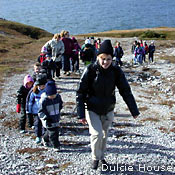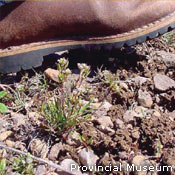Windswept and awe-inspiring, the barren-looking limestone of Burnt Cape is one of the most important botanical sites on the Island of Newfoundland.
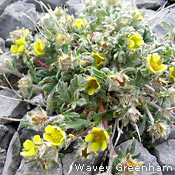
- How to get There
- Activities
- Maps
- Services
- Fees and Schedules
- Rules and Regulations
- Permits
- Other Resources
- Contact Information
Located near the tip of the Great Northern Peninsula and surrounded on three sides by cold waters from the Strait of Belle Isle, the peninsula of Burnt Cape has some of the most arctic conditions on the Island of Newfoundland. But it is exactly this cold climate, together with a unique landscape and calcium-rich soil, that allows northern plant species to grow here in a rich and rare variety.
The 3.6-km2 ecological reserve takes up almost all of the Burnt Cape peninsula. And though it may have the coolest conditions on the Island, the Cape is home to more than 300 plant species-about 30 of which are considered rare.
From a distance the Cape appears desolate, yet up close, particularly during the months of June and July, the tiny arctic plants provide a rainbow carpet of colour. Some of these plants are growing at their southernmost limits, others are at their northernmost. Some can be found only in a few other areas in northwest Newfoundland. Among the most significant are arctic bladderpod, alpine arnica, dwarf hawk’s beard, Burnt Cape cinquefoil-the Northern Peninsula is the only place in the world where this species grows-and the threatened Fernald’s braya (COSEWIC, 2000). These arctic-alpine plants are relicts of the flora that invaded when the last glaciers retreated.
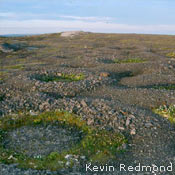
The Cape’s arctic conditions have also led to the formation of “frost polygons”-strange, geometric circles or lines of rocks on the surface of the ground. Caused by intense freeze/thaw cycles, they are usually found only in northern or Arctic areas of permafrost.
The creation of the reserve is a tribute to the efforts of local citizens, concerned supporters, scientists, conservation groups, and government. With their support, Burnt Cape Ecological Reserve was fully designated in March, 2000, to protect the area’s high concentration of plant species, particularly its three dozen rare plants. Ongoing efforts to protect the flora at Burnt Cape include research by Memorial University on the impacts of climate change and pathogens on the rare plants.
Visitors to the Cape should be prepared for a chilly time, even in summer. Frost can occur in any month of the year, and there is frequent rain and fog. The growing season in the Strait of Belle Isle Barrens ecoregion is the shortest on the Island.
Nevertheless, the Cape can be a wonderful place to see rare plants, watch passing icebergs, find fossils and unique geological features, and spot whales, wildlife, and birds.
How to get there
From Deer Lake and the Trans-Canada Highway, Burnt Cape is 420 km north up Routes 430, 436, and 437 (to Raleigh). The reserve is 1 km northwest of the community of Raleigh.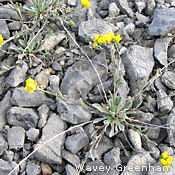
There is a rough road through the reserve that predates reserve establishment. Motorized vehicles are restricted to this route. Motorized vehicles can destroy plants and compact soil, which may prevent any new plants from growing. Because the plants are quite small and often difficult to spot, please watch your step while in the Reserve. Some of these plants are so rare, they can only be found on the limestone barrens of the Northern Peninsula.
Activities
In addition to viewing the plants (most of which bloom from late spring to July), sightseeing at the Cape can include spotting icebergs, birds, and whales.
Outdoor recreational activities at the Cape include the following:
Because of the vulnerability of the plants, camping, hunting, and trapping are not permitted, and building fires is prohibited.
Motorized vehicles are restricted to the main road through the reserve.
Hiking
Hiking tours of Burnt Cape Ecological Reserve are available through Burnt Cape Cabins in Raleigh.
Because of the vulnerability of the rare plants, we encourage visitors to the Cape to stay on the road and path, do not step on plant life, and be careful when approaching the coastline and its two-storey-high sheer cliffs-particularly in foggy or windy conditions.
Of particular note as hiking destinations are the coastal areas on the western and northwest shore of the Cape. Fossils and sea caves occur there, including the spectacular arched “Big Oven” at Whale Cove. On the northwest side of the Cape, a smaller cave (“Little Oven”) is also much photographed.
The Cape is an excellent place to spot birds that are more commonly found in the Arctic. These include gyrfalcon, and ivory gull.
During the early summer, the favoured breeding habitat is the forest growing in the limestone troughs and in the southern part of the reserve, and the shorter tuckamore. Look for black-capped chickadee, Swainson thrush, yellow-rumped warbler, American robin, white-crowned sparrow, pine grosbeak, and the ground-nesting short-eared owl. The Cape also hosts migrating shorebirds during the late summer, including semi-palmated sandpiper and ruddy turnstone.
Winter can also be a good time to bird watch at the Cape-on the water, when seabirds look for open leads in the ice. Of particular interest is the occasional appearance of ivory gull, a species of special concern (COSEWIC, 2001), on the pack ice. Burnt Cape is one of the few places this species can be seen from land.
The wooded end of the Cape hosts small mammals including masked shrew, meadow vole, and fox, and moose have been known to bed overnight in the Cape’s forests or wind-stunted fir. In winter, caribou from the St. Anthony herd appear on the barrens.
Hunting
Local residents may hunt seabirds (sea ducks and murres) from the reserve area, as long as they do so according to federal and provincial regulations.
Scientific Research
See Science and Research for information about how to conduct research in the reserve.
Services
The landscape at Burnt Cape has been left in-or restored to-its natural state. There are no buildings or signs inside the reserve’s borders.
Tours of Burnt Cape Ecological Reserve are available through Burnt Cape Cabins in Raleigh. The community of Raleigh is 1 km from the reserve.
Fees and Schedule
Burnt Cape Ecological Reserve can be accessed year-round and there are no fees associated with visiting the Reserve. Most people visit the reserve during the summer months. This is when most of the plants are in bloom, icebergs and whales appear offshore, and many birds use the Cape for breeding.
There are no fees involved in obtaining scientific research, commercial operator, or educational tour permits.
Rules and Regulations
Biodiversity protection and habitat conservation are two of the key purposes of ecological reserves, so certain rules apply within all the reserves in the province.
The public can visit most ecological reserves for educational purposes or low-impact recreational activities, such as hiking or sightseeing. This is true at Burnt Cape, although because of the rare plants’ vulnerability, taking a guided tour is strongly recommended.
At the Burnt Cape Ecological Reserve:
- No entry permit is required, though visitors are asked to avoid walking on the tiny arctic-alpine plants while in the reserve.
- Because of the vulnerability of the plants, camping, hunting, fishing, and trapping are not permitted in the reserve, and building fires is prohibited.
- Taking plant cuttings and seeds is prohibited.
The following activities are strictly prohibited in all wilderness and ecological reserves:
- disturbing, destroying, or removing plants or animals
- introducing plants, animals, or anything else to the reserve landscape
- forestry, mining (including exploration), hydro development, agriculture, new roads, tracks, or building construction
- driving off-road vehicles including all-terrain vehicles (ATVs)
Photographers should be particularly careful not to step on one tiny plant when getting the “best shot” of another.
Read the official reserve regulations:

